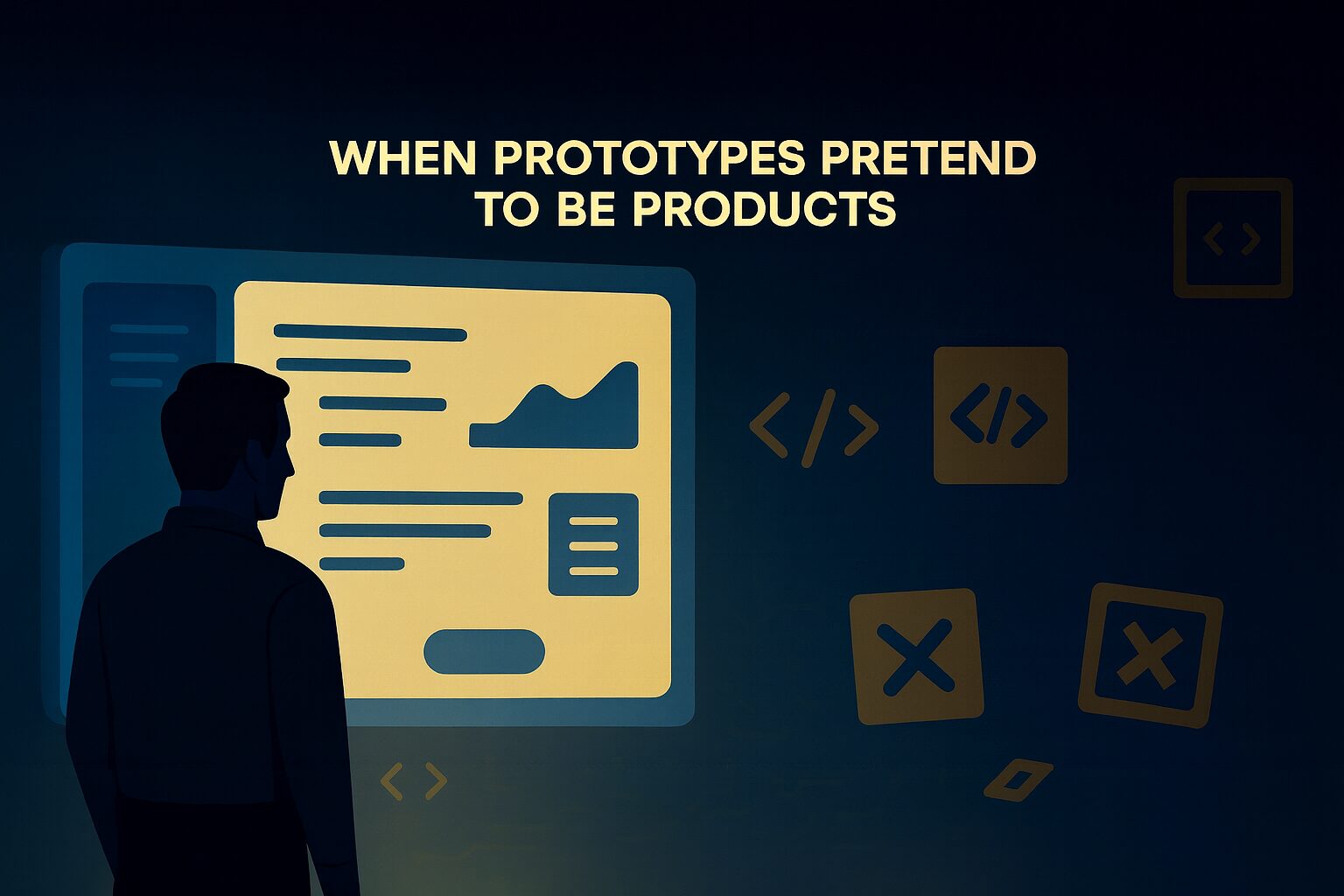
Over the past year, there’s been an explosion of AI coding tools that promise to turn subject-matter experts into software builders. Cursor, Windsurf, Lovable, Bolt, and a dozen others have made it feel possible to generate product features at a pace that would have been unthinkable even two years ago.
And it’s true that these tools give non-engineers something powerful: the ability to turn their ideas into functional prototypes without hiring a development team. That is a huge step forward. For many founders, especially domain experts, it’s the first time they’ve ever felt actual momentum in software development.
But here’s the part most people don’t talk about until they hit a wall. The output generated by these tools often looks like software, behaves like software for a short period of time, and gives you a sense that you’re close to the finish line. But underneath, the structure simply isn’t there. The foundation is missing. And the moment you try to expand the product, stabilize it, or bring in other engineers, everything slows down or falls apart.
This isn’t a knock on the ambition behind these tools. Their value is real. The gap is that they move faster than your architecture can support.
And unless you understand that dynamic early, you risk sinking months of effort into a system that becomes harder to maintain with each new feature you add.
This post is meant to help founders understand why this happens and what to do next.
Why founders get an MVP that looks impressive but behaves unpredictably
Let’s start with the pattern that’s becoming pretty common. A motivated founder or professional builds nights and weekends. They put hundreds of hours into shaping a workflow, polishing screens, and wiring up a handful of features. They watch in real time as an AI coding tool spits out React components, API handlers, ingestion logic, temporal workflows, or whatever they need next.
And at first, everything feels promising. The tool answers your prompts. It gives you runnable code. You see UI screens that look legitimate. Then you hit one or more of the same issues we see in audits:
- Something breaks every time you add a feature.
- The app becomes slow and you can’t tell why.
- A function that worked yesterday suddenly stops working when you tweak an unrelated file.
- You don’t know where anything lives in the repo.
- The application feels like a set of disjointed parts rather than an actual product.
And the most painful one. A senior engineer reviews the code and immediately says, “This has to be rebuilt.”
The founder, understandably, feels blindsided. “How is that possible? I have spent hundreds of hours on this. The whole thing works. I’m almost done.”
They’re not wrong. They did get far. But they didn’t get the part that matters most.
What AI coding tools produce: features without architecture
AI coding assistants excel at generating code in isolation. They follow your instructions, implement discrete tasks, and fill in missing pieces. But they aren’t software architects. They don’t create the underlying structure that coordinates everything else.
In many of these repos, you’ll see patterns like:
- UI components scattered across random folders
- Backend logic repeating itself in multiple places
- No single source of truth for configuration
- Workers, pipelines, or event systems set up in inconsistent ways
- File structures that evolve based on whatever prompt the founder used that night
- A system that technically runs, but has no backbone to support growth
One founder I recently spoke with had five separate folders named “frontend,” each holding a different slice of UI logic. Another had Temporal activities but no clear workflow folder. In some repos, configuration files appear in places that make no logical sense. In others, there’s heavy reliance on autopilot code that looks correct but isn’t connected to anything meaningful.
None of this is the founder’s fault.
It’s a limitation of the tools.
AI models can write code.
They can’t make engineering decisions.
So you end up with something that resembles a finished product when viewed from a distance, but behaves like a collage when you get close.
The moment when your Vibe-coded system starts to collapse
Every founder using these tools eventually reaches the same inflection point. They stop adding new features and start trying to stabilize what’s already there.
This is the point where the cracks show.
Small changes begin to break unrelated parts of the system. Latency creeps in because background tasks are stitched together instead of being designed. State gets out of sync. The app won’t scale beyond one or two users because there’s no separation of concerns. You fix one bug, and two more appear.
When founders tell me, “It works… but it’s slow,” that usually means:
- The pipelines weren’t designed with load in mind
- Tasks are chained together in non-deterministic ways
- There’s no caching strategy
- Nothing was built with a real concurrency model
- SQL or NoSQL structures are auto-generated and fragile
- The logic between ingestion, retrieval, summarization, and presentation is tied together with whatever pattern the LLM guessed at the time
The surface is polished. The internals are brittle.
This is why even the best AI-generated MVPs reach a ceiling.
Why debugging becomes almost impossible
If you’re a non-technical founder, here’s the most honest explanation I can give you.
Your repo doesn’t behave like something a human team built.
It behaves like something an LLM stitched together without understanding the long-term consequences.
That means:
- There’s no roadmap of how it was built.
- There’s no consistent pattern to follow.
- No one (including the AI tool) knows how the pieces depend on each other.
- A senior engineer can’t safely modify one part without risking breakage somewhere else.
This is why most senior engineers won’t take on projects built entirely through vibe-coded tools. They don’t want to be responsible for a system where the architecture is effectively accidental.
Why a rebuild is often the fastest path forward
This is the part no founder wants to hear, but every founder ends up confronting sooner or later.
Rebuilding isn’t a punishment for using AI tools. It’s the natural next step.
Your prototype captured the idea, the workflows, the screens, and the logic of your product. Those are the hardest parts for a team to learn. You’ve already done that thinking. But the underlying code isn’t something you can scale, expand, or bring into production without risking constant regression.
Think of your AI-generated MVP as a specification written in code form. A great one, honestly.
Better than a 100-page PRD. Better than a set of mockups. Better than a pitch deck. It shows what you want to build in living form.
But it isn’t the final version.
What a healthier next step looks like
Stop adding features. Every new line of code adds more instability. Have a team audit the system with the goal not to salvage it, but to understand it. I say the goal isn’t to save the existing code because what you want to do is to extract the product logic, workflows, and mental models behind it. Then you can rebuild the foundation in a structured environment. This may mean a traditional framework. Or it may mean a runtime built for structured automation and LLM-heavy workflows, like Wippy.
The key is that the new system has:
- Consistent conventions
- Defined boundaries
- Clear ownership of logic
- Predictable behavior
- A place for each feature to live
- Guardrails to stop chaos from creeping in
This is the part AI coding tools cannot give you today.
Why this isn’t wasted time
Founders often feel discouraged when they realize their AI-generated system needs a second life. It can feel like losing months of work.
But that’s not what happened.
You did the hardest thing. You figured out the product.
You learned what users need, you shaped how the workflows should behave, you prototyped the logic, and you validated patterns. You’ve already done the deep thinking a development team normally spends months trying to extract from a founder.
Nothing about that is wasted. It’s the reason the rebuild goes faster. It’s the reason the final system will be stronger.
The prototype you generated is the blueprint. The rebuild is the construction. They are two different stages of the same process.
If you’re at the point where things are slowing down, you’re not alone
If you’ve built something substantial using Cursor, Windsurf, Lovable, or another AI assistant and you’re suddenly seeing the cracks, that’s not a failure on your part. It’s a sign that you’ve outgrown what these tools can do on their own.
If you’re wondering whether your MLP is salvageable, whether it needs an architectural overhaul, or whether a structured agent platform like Wippy would accelerate the next stage, reach out. I’m happy to look at what you’ve built and give you an honest view of what’s possible – and how to get there without starting from zero.



